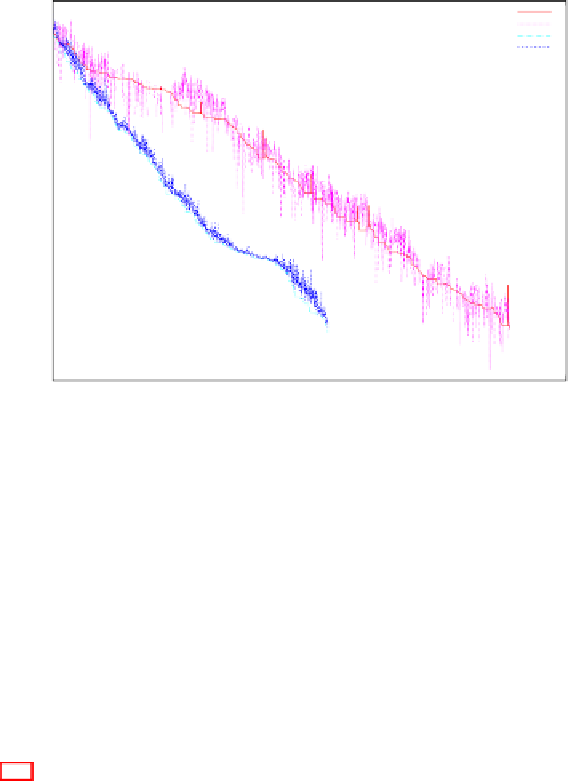Information Technology Reference
In-Depth Information
10000
TSES+, sex o
TSES+, sex c
TSES. sex o
TSES, sex c
100
1
0.01
0.0001
1e-006
1e-008
1e-010
0
500
1000
1500
2000
2500
3000
3500
generations
Fig. 7.7.
Fitness development of typical runs of the TSES and the modification TSES+
on problem 2.40. The figure shows the fitness development of both sexes on a logarith-
mic scale. The TSES+ is faster and its sex
o
is less fluctuating.
On problem g12 we observe a high quality of results with regard to the ac-
curacy of the data structure. The (8+8,15+85)-, the (8+8,13+87)- as well as
the (8+8,10+90)-TSES find the optimum with satisfying accuracy. The only
exception is the (8+8, 13+87)-TSES with a fixed initial starting point. This re-
sult can be explained with outliers, as the neighboring sex ratios are successful.
Again, we observe a saving of constraint function calls in comparison to death
penalty.
Figure 7.7 shows a typical run of the TSES on problem 2.40 on a logarithmic
scale. The negative fitness of sex
o
is shown, since the individuals are located on
theinfeasiblesideoftheoptimum.The
o
-individuals are oscillating during the
optimization, because they are
jumping
ontotheinfeasiblesideineverystep.
The figure also shows a TSES variant with a two step selection operator for sex
o
, the TSES+. It shows significant performance wins. The selection operator is
modified as follows: at first,
μ
o
individuals with sex
o
are selected by objective
function. In the second step,
μ
o
<μ
o
individuals of the
μ
o
ones are selected by
fulfillment of constraints. The fastest run of the TSES+ reached the optimum
within 2117 generations, the TSES needed 3830 generations. The median could
be improved from 3219 to 5320 generations. The variance among the TSES+
o
-individuals in each generation is smaller than the variance among the TSES
o
-
individuals. Obviously, the
o
-individuals jump only slightly across the constraint
boundary and thus enable a faster approximation of the optimum.









Search WWH ::

Custom Search